The trimming and forming system market is forecast to grow from USD 277.6 million in 2025 to USD 465.4 million by 2035, expanding at a CAGR of 5.3%, with overall size increasing by nearly 1.7 times over the period. Growth is driven by escalating demand for precision component processing systems in semiconductor packaging and automation upgrades across electronics assembly and industrial fabrication facilities. The market will gain strength from the integration of automated trimming and forming systems that deliver consistent dimensional control, superior surface finish, and optimized production throughput. Semiconductor packaging plants account for 67% of the market share, highlighting the critical dependence on these systems for fine-pitch components and compact chip packages that require uniform processing characteristics.
Between 2025 and 2030, trimming and forming system sales will expand to USD 341.4 million, accounting for 34% of the decade’s total growth, supported by miniaturization trends in integrated circuits, demand for tighter tolerances, and factory digitalization programs. By 2035, market value will reach USD 465.4 million, adding USD 124 million from 2030 onward, with expansion linked to adaptive control systems, inline metrology, and intelligent process algorithms integrated with manufacturing execution systems. Regional momentum will remain concentrated in Asia Pacific, led by China (7.2% CAGR) and India (6.6% CAGR), where national electronics manufacturing schemes are promoting the expansion of the semiconductor ecosystem. Germany (6.1% CAGR) anchors European precision equipment deployment, while the US (5%) continues to invest in advanced automation and quality compliance infrastructure. Competitive advantage will hinge on tooling precision, automation reliability, and process integration depth, with suppliers such as Anhui Dahua Semiconductor, Guangdong Taijin, and ASMPT SEMI Solution leveraging design optimization, advanced control architecture, and tailored after-sales service to secure industrial partnerships.
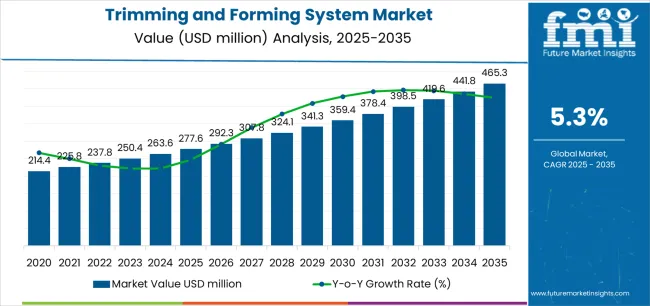
The market demonstrates strong momentum across established and emerging electronics manufacturing economies, where semiconductor packaging industries are transitioning from manual processing methods to automated systems that offer superior performance characteristics and operational consistency. Trimming and forming technology addresses critical manufacturing challenges including dimensional accuracy maintenance in miniaturized component processing, surface quality control in precision trimming operations, and throughput consistency across extended production runs. The semiconductor industry shift toward compact packaging designs and multi-functional component configurations creates sustained demand for processing equipment capable of handling complex geometries with minimal variation and consistent quality output. Electronics manufacturers are adopting trimming and forming systems for critical component preparation where dimensional precision directly impacts assembly yield and final product reliability requirements. The technology capability to produce components with excellent surface finish characteristics reduces rework operations and accelerates production workflows.
Semiconductor packaging facilities and electronics contract manufacturers are investing in trimming and forming systems to enhance competitive positioning through improved quality metrics and expanded processing capabilities. The integration of precision control mechanisms and automated quality verification enables these systems to achieve dimensional accuracy levels exceeding manual processing while maintaining production speed requirements. However, initial equipment investment requirements for advanced processing systems and technical expertise barriers for optimal parameter configuration may pose challenges to market expansion in cost-sensitive manufacturing segments and regions with limited access to specialized technical training resources and application engineering support.
Between 2025 and 2030, the trimming and forming system market is projected to expand from USD 277.6 million to USD 341.4 million, resulting in a value increase of USD 63.8 million, which represents 34% of the total forecast growth for the decade. This phase of development will be shaped by rising demand for automated component processing solutions in semiconductor packaging facilities, product innovation in precision control technology and automated inspection systems, as well as expanding integration with advanced manufacturing execution platforms and quality control frameworks. Companies are establishing competitive positions through investment in high-precision processing mechanisms, advanced tooling technologies, and strategic market expansion across semiconductor packaging facilities, electronic assembly plants, and specialized component manufacturing operations.
From 2030 to 2035, the market is forecast to grow from USD 341.4 million to USD 465.4 million, adding another USD 124 million, which constitutes 66% of the overall ten-year expansion. This period is expected to be characterized by the expansion of intelligent processing systems, including adaptive control algorithms and real-time quality monitoring configurations tailored for specific component types and dimensional requirements, strategic collaborations between equipment manufacturers and semiconductor packaging companies, and an enhanced focus on processing precision optimization and yield enhancement. The growing emphasis on manufacturing quality and operational efficiency will drive demand for advanced, high-performance trimming and forming solutions across diverse semiconductor packaging applications.
| Metric | Value |
|---|---|
| Market Value (2025) | USD 277.6 million |
| Market Forecast Value (2035) | USD 465.4 million |
| Forecast CAGR (2025-2035) | 5.3% |
The trimming and forming system market grows by enabling manufacturers to achieve superior component dimensional accuracy and surface quality while reducing processing cycle times in precision semiconductor packaging operations. Manufacturing facilities face mounting pressure to improve production quality and operational efficiency, with trimming and forming systems typically providing consistent dimensional control and improved processing reliability compared to manual methods, making these specialized systems essential for competitive electronics manufacturing operations. The semiconductor packaging and electronics assembly industries need for precise component finishing creates demand for advanced processing solutions that can maintain tight tolerances, achieve excellent surface characteristics, and ensure consistent dimensional accuracy across diverse component types and production volumes.
Industrial automation initiatives promoting production integration and quality standardization drive adoption in semiconductor packaging facilities, electronic assembly operations, and specialized component manufacturing, where processing precision has a direct impact on assembly yield and product reliability. The global shift toward miniaturization principles and smart manufacturing implementation accelerates trimming and forming system demand as electronics facilities seek processing solutions that minimize dimensional variations and maximize quality consistency. However, limited awareness of optimal processing parameters and higher initial equipment costs compared to manual processing methods may limit adoption rates among small-scale electronics manufacturers and regions with traditional manufacturing practices and limited technical expertise and application engineering support infrastructure.
The market is segmented by automation level, application, and region. By automation level, the market is divided into fully automatic, semi-automatic, and others. Based on application, the market is categorized into semiconductor packaging plant and electronic assembly plant. Regionally, the market is divided into Asia Pacific, Europe, North America, Latin America, and Middle East & Africa.
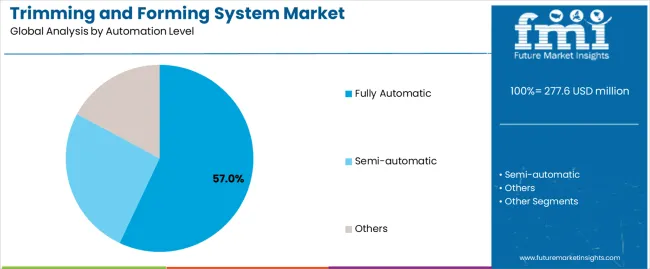
The fully automatic segment represents the dominant force in the trimming and forming system market, capturing approximately 57% of total market share in 2025. This category encompasses integrated automation configurations optimized for high-volume semiconductor packaging requirements, delivering consistent dimensional accuracy and reliable processing performance across diverse component types. The fully automatic segment market leadership stems from its advanced control architecture, reduced labor dependency, and compatibility with modern production line infrastructures across semiconductor packaging facilities and electronic assembly operations.
The semi-automatic segment maintains a substantial 34% market share, serving manufacturers who require flexible processing capabilities through operator-assisted automation features and adaptable processing configurations that balance automation benefits with operational flexibility.
Key advantages driving the fully automatic segment include:
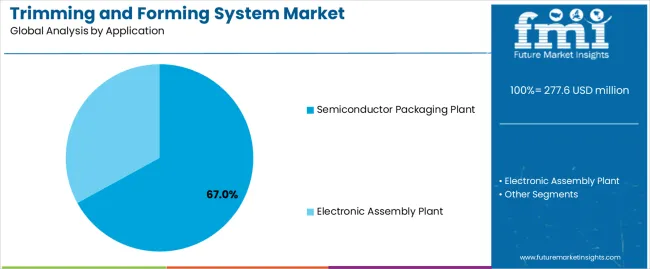
Semiconductor packaging plant applications dominate the trimming and forming system market with approximately 67% market share in 2025, reflecting the extensive adoption of precision processing solutions across integrated circuit packaging operations, discrete semiconductor manufacturing, and specialized component fabrication facilities. The semiconductor packaging plant segment market leadership is reinforced by widespread implementation in advanced package finishing, lead frame processing, and precision component preparation operations, which provide essential quality advantages and throughput consistency in high-volume production environments.
The electronic assembly plant segment represents 33% market share through specialized applications including component preparation operations, precision finishing requirements, and quality-critical assembly processes where dimensional accuracy impacts final product performance and assembly reliability.
Key market dynamics supporting application preferences include:
The market is driven by three concrete demand factors tied to manufacturing quality and efficiency outcomes. First, semiconductor industry expansion creates increasing requirements for precision processing solutions, with global semiconductor production facilities requiring reliable trimming and forming systems for advanced packaging operations, component finishing, and precision preparation manufacturing. Second, electronics miniaturization trends and stringent quality requirements drive adoption of automated processing technology, with trimming and forming systems improving dimensional consistency while reducing processing variations in semiconductor packaging applications. Third, manufacturing automation initiatives and production line integration accelerate deployment across electronics facilities, with trimming and forming systems integrating seamlessly into automated manufacturing lines and enabling consistent quality capabilities in high-volume production environments.
Market restraints include initial investment barriers affecting small-scale electronics manufacturers and cost-sensitive production operations, particularly where manual processing methods remain adequate for less demanding applications and where capital budgets constrain adoption of automated processing systems. Technical configuration requirements for optimal system performance pose adoption challenges for facilities lacking processing expertise, as trimming and forming system effectiveness depends heavily on proper parameter selection, tooling configuration, and quality control integration that vary significantly across production environments. Limited availability of application-specific technical support in emerging electronics manufacturing markets creates additional barriers, as production facilities require specialized knowledge in system operation procedures, troubleshooting methods, and maintenance practices to achieve target processing quality levels.
Key trends indicate accelerated adoption in Asian electronics manufacturing hubs, particularly China and India, where semiconductor packaging operations and electronics assembly capabilities are expanding rapidly through government industrialization programs and foreign direct investment in manufacturing infrastructure. Technology advancement trends toward intelligent process control with adaptive capabilities, integrated quality inspection for real-time verification, and modular system architectures enabling rapid configuration changes are driving next-generation product development. However, the market thesis could face disruption if integrated processing capabilities in semiconductor packaging equipment achieve breakthrough functionalities in combined trimming and forming operations, potentially reducing demand for standalone processing systems in specific application segments.
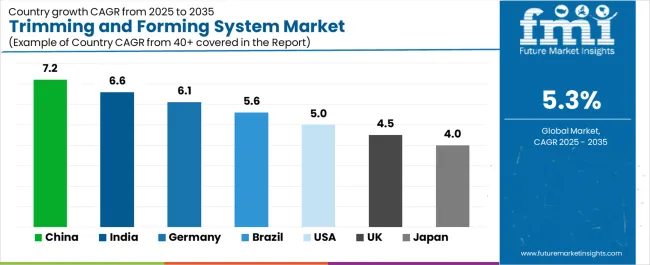
| Country | CAGR (2025-2035) |
|---|---|
| China | 7.2% |
| India | 6.6% |
| Germany | 6.1% |
| Brazil | 5.6% |
| USA | 5% |
| UK | 4.5% |
| Japan | 4% |
The trimming and forming system market is gaining momentum worldwide, with China taking the lead thanks to aggressive semiconductor manufacturing expansion and industrial automation programs. Close behind, India benefits from growing electronics assembly operations and government manufacturing initiatives, positioning itself as a strategic growth hub in the Asia-Pacific region. Brazil shows strong advancement, where expanding electronics production facilities and manufacturing infrastructure development strengthen its role in South American electronics supply chains. The USA demonstrates robust growth through advanced semiconductor packaging initiatives and electronics sector investment, signaling continued adoption in precision processing applications. Meanwhile, Japan stands out for its precision manufacturing expertise and advanced processing technology integration, while UK and Germany continue to record consistent progress driven by electronics manufacturing facilities and industrial equipment production. Together, China and India anchor the global expansion story, while established markets build stability and technology leadership into the market growth path.
The report covers an in-depth analysis of 40+ countries, the top-performing countries are highlighted below.
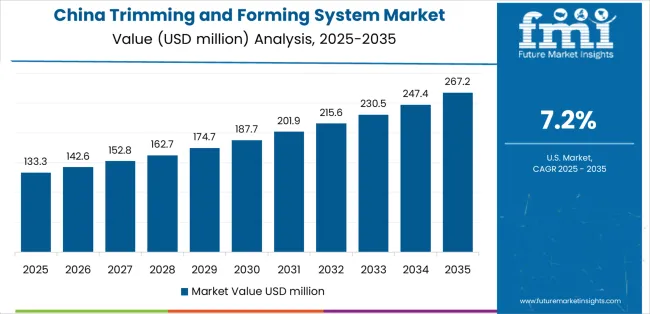
China demonstrates the strongest growth potential in the Trimming and Forming System Market with a CAGR of 7.2% through 2035. The country leadership position stems from comprehensive semiconductor manufacturing expansion, intensive electronics industry development programs, and aggressive industrial automation targets driving adoption of advanced processing technologies. Growth is concentrated in major electronics manufacturing regions, including Guangdong, Jiangsu, Zhejiang, and Shanghai, where semiconductor packaging facilities, electronics assembly operations, and component manufacturing plants are implementing trimming and forming systems for quality enhancement and productivity improvement. Distribution channels through industrial equipment distributors, processing technology specialists, and direct manufacturer relationships expand deployment across semiconductor clusters, electronics production bases, and precision component manufacturing centers. The country Made in China 2025 initiative provides policy support for advanced manufacturing technology adoption, including subsidies for precision equipment implementation and manufacturing upgrading programs.
Key market factors:
In the National Capital Region, Karnataka, Tamil Nadu, and Maharashtra electronics zones, the adoption of trimming and forming systems is accelerating across semiconductor packaging facilities, electronics assembly operations, and component manufacturing plants, driven by Make in India initiatives and increasing focus on manufacturing competitiveness. The market demonstrates strong growth momentum with a CAGR of 6.6% through 2035, linked to comprehensive electronics sector expansion and increasing investment in processing capabilities. Indian manufacturers are implementing trimming and forming technology and advanced processing platforms to improve production quality while meeting stringent precision requirements in semiconductor packaging and electronics assembly operations serving domestic and export markets. The country National Manufacturing Policy creates sustained demand for advanced processing solutions, while increasing emphasis on quality consistency drives adoption of precision processing systems that enhance manufacturing competitiveness.
Germany advanced electronics manufacturing sector demonstrates sophisticated implementation of trimming and forming systems, with documented case studies showing significant quality improvements in semiconductor packaging operations through optimized processing strategies. The country manufacturing infrastructure in major industrial regions, including Bavaria, Baden-Wurttemberg, North Rhine-Westphalia, and Saxony, showcases integration of precision processing technologies with existing production facilities, leveraging expertise in electronics manufacturing and component fabrication. German manufacturers emphasize quality standards and process optimization, creating demand for reliable trimming and forming solutions that support quality commitments and stringent dimensional accuracy requirements. The market maintains strong growth through focus on Industry 4.0 integration and manufacturing excellence, with a CAGR of 6.1% through 2035.
Key development areas:
The Brazilian market leads in Latin American trimming and forming system adoption based on expanding electronics manufacturing operations and growing production infrastructure in major industrial centers. The country shows solid potential with a CAGR of 5.6% through 2035, driven by electronics sector investment and increasing domestic demand for precision-manufactured components across consumer electronics, automotive electronics, and industrial equipment sectors. Brazilian manufacturers are adopting trimming and forming technology for compliance with electronics industry quality standards, particularly in component processing requiring precise dimensional tolerances and in production operations where processing quality impacts manufacturing economics. Technology deployment channels through industrial distributors, equipment representatives, and financing programs expand coverage across electronics supply chains and component manufacturing facilities.
Leading market segments:
The USA market leads in advanced trimming and forming system applications based on integration with sophisticated production automation platforms and comprehensive manufacturing systems for enhanced production efficiency. The country shows solid potential with a CAGR of 5% through 2035, driven by semiconductor packaging expansion and increasing adoption of advanced processing technologies across electronics manufacturing, defense electronics, and industrial equipment production sectors. American manufacturers are implementing trimming and forming systems for high-precision processing requirements, particularly in advanced semiconductor packaging demanding tight tolerances and in electronics production where quality consistency directly impacts manufacturing economics. Technology deployment channels through industrial distributors, processing specialists, and direct manufacturer relationships expand coverage across diverse electronics operations.
Leading market segments:
The UK market demonstrates consistent implementation focused on electronics component manufacturing and specialized production operations, with documented integration of trimming and forming systems achieving quality improvements in component processing operations. The country maintains steady growth momentum with a CAGR of 4.5% through 2035, driven by electronics manufacturing presence and precision component requirements in advanced electronics applications. Major industrial regions, including South East England, East Midlands, and Scotland, showcase deployment of advanced processing technologies that integrate with existing manufacturing infrastructure and support quality requirements in electronics supply chains.
Key market characteristics:
Japan trimming and forming system market demonstrates sophisticated implementation focused on semiconductor packaging operations and precision electronics manufacturing, with documented integration of advanced processing systems achieving quality improvements in high-precision component processing operations. The country maintains steady growth momentum with a CAGR of 4% through 2035, driven by manufacturing excellence culture and emphasis on quality optimization principles aligned with lean manufacturing philosophies. Major industrial regions, including Tokyo, Osaka, Aichi, and Kyushu, showcase advanced deployment of precision processing technologies that integrate seamlessly with automated production lines and comprehensive quality control systems.
Key market characteristics:

The trimming and forming system market in Europe is projected to grow from USD 72.5 million in 2025 to USD 133.6 million by 2035, registering a CAGR of 6.3% over the forecast period. Germany is expected to maintain its leadership position with a 33.8% market share in 2025, declining slightly to 33.1% by 2035, supported by its extensive electronics manufacturing infrastructure and major industrial centers, including Bavaria, Baden-Wurttemberg, and North Rhine-Westphalia production regions.
France follows with a 20.1% share in 2025, projected to reach 20.4% by 2035, driven by comprehensive electronics component production and precision manufacturing programs in major industrial regions. The United Kingdom holds a 16.7% share in 2025, expected to reach 17% by 2035 through electronics manufacturing facilities and precision component operations. Italy commands a 13.2% share in both 2025 and 2035, backed by electronics production and machinery manufacturing. Spain accounts for 7.6% in 2025, rising to 7.8% by 2035 on electronics assembly operations and manufacturing sector growth. The Rest of Europe region is anticipated to hold 8.6% in 2025, expanding to 9.2% by 2035, attributed to increasing trimming and forming system adoption in Nordic countries and emerging Central & Eastern European electronics manufacturing operations.
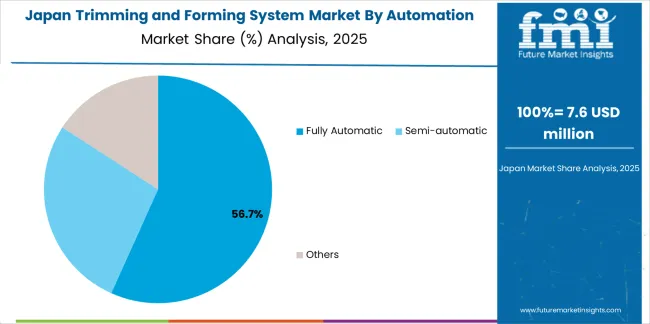
The Japanese trimming and forming system market demonstrates a mature and quality-focused landscape, characterized by sophisticated integration of automated processing systems with existing semiconductor packaging infrastructure across component production operations, electronics manufacturing, and precision assembly facilities. Japan emphasis on manufacturing excellence and quality assurance drives demand for precision processing equipment that supports quality commitments and productivity targets in competitive manufacturing environments. The market benefits from strong partnerships between international equipment providers and domestic industrial distributors including major trading companies, creating comprehensive service ecosystems that prioritize technical support and application engineering programs. Industrial centers in Tokyo, Osaka, Aichi, and other major manufacturing areas showcase advanced electronics implementations where trimming and forming systems achieve high dimensional accuracy compliance through optimized processing parameters and comprehensive quality control systems.

The South Korean trimming and forming system market is characterized by growing international technology provider presence, with companies maintaining significant positions through comprehensive technical support and application engineering capabilities for semiconductor packaging operations and precision electronics manufacturing applications. The market demonstrates increasing emphasis on manufacturing automation and quality enhancement, as Korean manufacturers increasingly demand advanced processing solutions that integrate with domestic production infrastructure and sophisticated quality management systems deployed across major industrial complexes. Regional equipment distributors are gaining market share through strategic partnerships with international manufacturers, offering specialized services including technical training programs and application-specific processing solutions for semiconductor and electronics production operations. The competitive landscape shows increasing collaboration between multinational equipment companies and Korean industrial specialists, creating hybrid service models that combine international product development expertise with local technical support capabilities and rapid response systems.
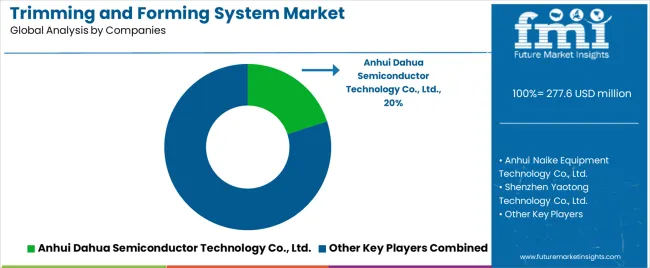
The trimming and forming system market features approximately 20-25 meaningful players with moderate fragmentation, where leading companies control market share through established distribution networks and comprehensive product portfolios. Competition centers on processing accuracy consistency, system reliability, and technical support capabilities rather than price competition alone. Market leaders maintain competitive advantages through specialized processing technology and established relationships with semiconductor packaging facilities and electronics manufacturers.
Market leaders include equipment manufacturers with global reach and advanced processing capabilities, which maintain competitive advantages through technical expertise, processing system integration capabilities, and deep application knowledge across multiple electronics sectors, creating trust and reliability advantages with semiconductor packaging operations and electronic assembly facilities. These companies leverage research and development capabilities in precision control optimization, automated inspection technology advancement, and ongoing technical support relationships to defend market positions while expanding into emerging electronics manufacturing markets and specialized application segments.
Challengers encompass regional equipment manufacturers and processing specialists, which compete through specialized product offerings and strong regional presence in key electronics manufacturing markets. Product specialists focus on specific system configurations or application segments, offering differentiated capabilities in custom processing solutions, rapid delivery services, and competitive pricing structures for standard configurations.
Regional players and emerging processing equipment manufacturers create competitive pressure through localized manufacturing advantages and rapid response capabilities, particularly in high-growth markets including China and India, where proximity to semiconductor packaging clusters provides advantages in technical support responsiveness and customer relationships. Market dynamics favor companies that combine proven processing performance with comprehensive application engineering offerings that address the complete processing cycle from system integration through quality optimization and performance assurance.
Trimming and forming systems represent advanced processing solutions that enable manufacturers to achieve consistent dimensional accuracy and surface quality while improving production efficiency, delivering superior component finishing capabilities and manufacturing quality with enhanced precision and process consistency in demanding semiconductor packaging applications. With the market projected to grow from USD 277.6 million in 2025 to USD 465.4 million by 2035 at a 5.3% CAGR, these precision processing systems offer compelling advantages - quality enhancement, productivity improvement, and operational consistency - making them essential for semiconductor packaging plant applications (67% market share), electronic assembly plant operations (33% share), and manufacturing facilities seeking alternatives to manual processing methods that compromise quality through inconsistent dimensional control and surface finish variations. Scaling market adoption and technology deployment requires coordinated action across industrial policy, manufacturing infrastructure development, equipment manufacturers, electronics production facilities, and industrial automation investment capital.
How Governments Could Spur Local Production and Adoption?
How Industry Bodies Could Support Market Development?
How OEMs and Technology Players Could Strengthen the Ecosystem?
How Suppliers Could Navigate the Shift?
How Investors and Financial Enablers Could Unlock Value?
| Item | Value |
|---|---|
| Quantitative Units | USD 277.6 million |
| Automation Level | Fully Automatic, Semi-automatic, Others |
| Application | Semiconductor Packaging Plant, Electronic Assembly Plant |
| Regions Covered | Asia Pacific, Europe, North America, Latin America, Middle East & Africa |
| Country Covered | China, India, Germany, Brazil, USA, UK, Japan, and 40+ countries |
| Key Companies Profiled | Anhui Dahua Semiconductor Technology Co., Ltd., Anhui Naike Equipment Technology Co., Ltd., Shenzhen Yaotong Technology Co., Ltd., Guangdong Taijin Semiconductor Technology Co., Ltd., Semipower Technology (Dongguan) Co., Ltd., Guoxin Intelligence, Zhuoer Semiconductor Equipment (Suzhou) Co., Ltd., Mepgroup, ASMPT SEMI Solution, Shenzhen Tianwei Electronics Co., Ltd., Nextool Technology, Anhui Zhonghe Semiconductor Technology Co., Ltd. |
| Additional Attributes | Dollar sales by automation level and application categories, regional adoption trends across Asia Pacific, Europe, and North America, competitive landscape with processing equipment manufacturers and distribution networks, manufacturing facility requirements and specifications, integration with automated production lines and quality control systems, innovations in precision control technology and automated inspection platforms, and development of specialized processing solutions with enhanced dimensional accuracy and surface quality capabilities. |
The global trimming and forming system market is estimated to be valued at USD 277.6 million in 2025.
The market size for the trimming and forming system market is projected to reach USD 465.3 million by 2035.
The trimming and forming system market is expected to grow at a 5.3% CAGR between 2025 and 2035.
The key product types in trimming and forming system market are fully automatic, semi-automatic and others.
In terms of application, semiconductor packaging plant segment to command 67.0% share in the trimming and forming system market in 2025.






Full Research Suite comprises of:
Market outlook & trends analysis
Interviews & case studies
Strategic recommendations
Vendor profiles & capabilities analysis
5-year forecasts
8 regions and 60+ country-level data splits
Market segment data splits
12 months of continuous data updates
DELIVERED AS:
PDF EXCEL ONLINE
Integrated Trimming and Forming System Market Size and Share Forecast Outlook 2025 to 2035
Thread Trimming Machine Market Size and Share Forecast Outlook 2025 to 2035
Android Automotive OS (AAOS) Market Size and Share Forecast Outlook 2025 to 2035
Anderson Cascade Impactor Market Size and Share Forecast Outlook 2025 to 2035
Andersen-Tawil Syndrome Treatment Market Trends - Growth & Future Prospects 2025 to 2035
Andro Supplements Market
Candle Filter Cartridges Market Size and Share Forecast Outlook 2025 to 2035
Handheld Electrostatic Meter Market Size and Share Forecast Outlook 2025 to 2035
Hand Towel Automatic Folding Machine Market Size and Share Forecast Outlook 2025 to 2035
Handheld Ultrasound Scanner Market Size and Share Forecast Outlook 2025 to 2035
Handheld Tagging Gun Market Forecast and Outlook 2025 to 2035
Hand Tools Market Size and Share Forecast Outlook 2025 to 2035
Land Survey Equipment Market Size and Share Forecast Outlook 2025 to 2035
Handloom Product Market Size and Share Forecast Outlook 2025 to 2035
Band File Sander Belts Market Size and Share Forecast Outlook 2025 to 2035
Handheld XRF Analyzers Market Size and Share Forecast Outlook 2025 to 2035
Sand Abrasion Tester Market Size and Share Forecast Outlook 2025 to 2035
Sand Testing Equipments Market Size and Share Forecast Outlook 2025 to 2035
Landscape Lighting Market Size and Share Forecast Outlook 2025 to 2035
Handheld Police Radar Guns Market Size and Share Forecast Outlook 2025 to 2035

Thank you!
You will receive an email from our Business Development Manager. Please be sure to check your SPAM/JUNK folder too.
Chat With
MaRIA